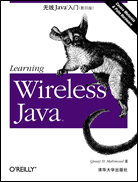
无线Java入门(影印版)
出版时间:2002年11月
页数:264
直到现在,Java开发者还局限于桌面编程。然而,Sun Microsystems公司推出了Java 2 Platform,Micro Edition(J2ME),程序员现在可以为资源受限的设备开发Java应用程序了,这些设备具有较小的内存和有限的CPU功能。这一技术能够把激动人心的新的Java应用程序带入无线编程领域。
《无线Java入门(影印版)》可以让读者尽可能迅速地掌握新版本的J2ME,包括其配置和概要文件。本书介绍了连接受限设备配置(CLDC)和移动信息设备概要文件(MIDP),以及使用Sun Microsystems公司的灵巧的K虚拟机(KVM)的方法和技巧。另外,本书还介绍了基本的MIDlet编程技术,说明了如何使用通用连接框架进行网络支持,高端和低端图形API,以及用于永久性数据存储的J2ME记录管理系统。
本书的要点包括:
* 介绍J2ME的构架和Java无线工具包
* 详细分析了CLDC、MIDP和KVM与Java 2标准版的区别
* 深入分析了MIDP GUI API的应用
* 介绍了如何使用通用连接框架和HTTP通过Internet与服务器交互数据
* 讨论了如何使用MIDP记录管理系统保存数据
* 对于在Motorola i85s/i50x和与Palm连接的设备部署J2ME应用程序做了详细的指导
* 提供了每一个CLDC和MIDP软件包和类的详细的快速参考
Qusay H.Mahmoud是Sun Microsystems公司的独立签约人。他为Java Developer Connection撰写过多篇有关J2ME的文章,内容也涉及到MIDP和CLDC API等内容。他出席过许多有关开发无线Java应用程序的国际会议。他还是Distributed Programming with Java一书的作者。
《无线Java入门(影印版)》可以让读者尽可能迅速地掌握新版本的J2ME,包括其配置和概要文件。本书介绍了连接受限设备配置(CLDC)和移动信息设备概要文件(MIDP),以及使用Sun Microsystems公司的灵巧的K虚拟机(KVM)的方法和技巧。另外,本书还介绍了基本的MIDlet编程技术,说明了如何使用通用连接框架进行网络支持,高端和低端图形API,以及用于永久性数据存储的J2ME记录管理系统。
本书的要点包括:
* 介绍J2ME的构架和Java无线工具包
* 详细分析了CLDC、MIDP和KVM与Java 2标准版的区别
* 深入分析了MIDP GUI API的应用
* 介绍了如何使用通用连接框架和HTTP通过Internet与服务器交互数据
* 讨论了如何使用MIDP记录管理系统保存数据
* 对于在Motorola i85s/i50x和与Palm连接的设备部署J2ME应用程序做了详细的指导
* 提供了每一个CLDC和MIDP软件包和类的详细的快速参考
Qusay H.Mahmoud是Sun Microsystems公司的独立签约人。他为Java Developer Connection撰写过多篇有关J2ME的文章,内容也涉及到MIDP和CLDC API等内容。他出席过许多有关开发无线Java应用程序的国际会议。他还是Distributed Programming with Java一书的作者。
- Preface
- Part I. Introducing Java 2 Platform, Micro Edition (J2ME)
- 1. Overview of J2ME
- What Is J2ME?
- Downloading the J2ME Wireless Toolkit
- A Simple Example
- 2. The Connected Limited Device Configuration (CLDC)
- Examining the CLDC in Detail
- Using the Standalone CLDC and KVM
- CLDC Next Generation 30
- 3. The Mobile InformationDevice Profile (MIDP)
- Mobile Information Devices
- More About MIDlets
- Part II. Programming with the CLDC and the MIDP
- 4. Working with MIDlets
- The Application Manager
- Creating MIDlets
- 5. MIDP GUI Programming
- Why Not Reuse the AWT?
- The MIDP GUI APIs
- The High-Level MIDP APIs
- Creating Low-Level GUI Components
- 6. MIDP Events
- Screen Navigation
- Handling Low-Level Events
- 7. Networking
- Generic Connections
- MIDP Connectivity
- The HTTP Programming Model
- Invoking Remote Applications from MIDlets
- Wireless Session Tracking
- MIDlet Networking Security
- 8. Database Programming
- The Record Management System
- Programming with the RMS
- 9. The MIDP for Palm OS
- Installing the MIDP for Palm OS on the Windows Platform
- Developing New Applications
- PRC Command-Line Conversion
- Advanced Java Applications
- A Final Thought
- Part III. API Quick Reference
- A. The java.io Package
- B. The java.lang Package
- C. The java.util Package
- D. The javax.microedition.io Package
- E. The javax.microedition.lcdui Package
- F. The javax.microedition.midlet Package
- G. The javax.microedition.rms Package
- H. Resources
- Index
书名:无线Java入门(影印版)
作者:Qusay H. Mahmoud 著
国内出版社:清华大学出版社
出版时间:2002年11月
页数:264
书号:7-302-05953-5
原版书出版商:O'Reilly Media
The animal on the cover of Learning Wireless Java is a Senegal galago. Galagos, also called bush babies, are native to forest and bush regions of sub-Saharan Africa, including the island of Zanzibar. Galagos have lightly built bodies with long hind legs for leaping. The flattened tips of their toes are padded with thick skin for gripping tree trunks and branches, and on each of their back feet, the index toe has an extended claw for grasping. Galagos leap from branch to branch, tree to tree, sometimes jumping as far as 15 feet.
The galago has soft, woolly fur, either brown or gray in color. Its face is small and pointy, with large eyes that allow it to see well in the dark. Its large,mobile ears can move either independently or simultaneously. The combination of the galago's huge eyes and mobile ears not only give the animal its trademark quizzical expression, but also aid the nocturnal galago after dark. At night, families of up to 20 galagos defend territories 15 to 20 acres in size. When a predator approaches, the galago emits a rasping shout that sounds much like an excited child.During the day, each family crowds into an enclosed space, such as a hollowed tree trunk,to sleep.
Galagos eat mostly insects, such as grasshoppers, dung beetles, and caterpillars,but they are also quick enough to catch mice, lizards, and small birds. In addition, they eat fruit, seeds, and flowers, sometimes aiding in pollination. In some parts of Africa, the Galago senegalensis, or "lesser bush baby,"is kept as a pet.
The galago has soft, woolly fur, either brown or gray in color. Its face is small and pointy, with large eyes that allow it to see well in the dark. Its large,mobile ears can move either independently or simultaneously. The combination of the galago's huge eyes and mobile ears not only give the animal its trademark quizzical expression, but also aid the nocturnal galago after dark. At night, families of up to 20 galagos defend territories 15 to 20 acres in size. When a predator approaches, the galago emits a rasping shout that sounds much like an excited child.During the day, each family crowds into an enclosed space, such as a hollowed tree trunk,to sleep.
Galagos eat mostly insects, such as grasshoppers, dung beetles, and caterpillars,but they are also quick enough to catch mice, lizards, and small birds. In addition, they eat fruit, seeds, and flowers, sometimes aiding in pollination. In some parts of Africa, the Galago senegalensis, or "lesser bush baby,"is kept as a pet.
购买选项